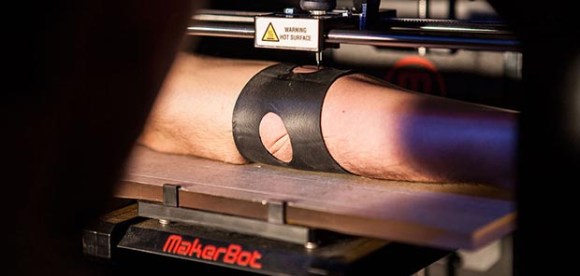
ENSCI les Ateliers, the famous design school in Paris, had a “Public Domain Remix” and hackathon recently, with teams splitting up to remix public domain and other free-to-use IP in projects. Most of the teams came up with similar ideas, but one team went above and beyond the call of duty; they turned a 3D printer into a tattoo machine, capable of inking a real, live human test subject.
The build began by plotting a circle with a pen onto a piece of paper. This evolved into printing a tool holder for a tattoo machine graciously provided by an amateur tattoo artist. Tests with “artificial skin” (any one care to hazard a guess at what that is?) were promising, and the team moved on to a human guinea pig.
The biggest problem the team faced is that humans aren’t flat. They tried a few tricks to tighten the skin around the area to be tattooed – metal rings, elastics, and finally the inner tube from a scooter. In the end, the team was able to tattoo a small circle on the forearm of the test subject.
It’s an extremely simple and small tattoo, and scaling this build up to a sleeve would be difficult. A better solution would be to create a point cloud of an arm before going for a much larger tattoo.














But can it do goatse?
lol maybe one day but for now (and the forseable future) I think I’ll pass.
“Not Sure”
Well played
Now under the lasercutter to remove it…
I laughed harder than I should have!
“Pig skin is the traditional practice skin used by tattoo apprentices since tattooing began to be popular. Long before plastic practice skin was invented, pig skin was readily available.”
http://tattoo-practice-skin.com/tattoo-practice-skin-pig-skin/
Also, honeydew melons, oranges, grapefruits, pig ears and pig feet from the butcher (if the skin isn’t available), are all acceptable mediums to practice on…
“…and the team moved on to a human guinea pig.”
Whom they dragged and tied down to the tattooing machine kicking and screaming, I’m sure. (c:
Nah, I’m sure they did it the traditional way…they looked for a drunk…
This could but skizie low lifes out of buisness everywhere!
…pretty sure it is easier to just go to a tattoo artist~!!!
Their mistake was not using an oeuf-bot.
That was my thought, as well. Though, I think the eggbot works by rotating the egg, which wouldn’t really work for an arm..
Exchange it for an over-sized Egg-Bot and you can be tattooing heads everywhere. Just in time for Easter.
(You don’t know hard hard it was for me not to type “egg-change” in the opening sentence)
Surely, you jest!…
Too many variables (even on individual bodies) to be run on a machine. At least in a practical enviroment. Toughness and density of dermal layers, ink acceptance, not to mention shading densities, dermal tension, etc, all on a moving body. And believe me, everybody moves.
I know of which I speak.
http://i150.photobucket.com/albums/s84/boattrash/Capt%20David%20Misc/IMGP6250.jpg
Dat’s my arm, since finished into a 1/2 shirt. Only machine I want to see is one that goes bzzzzzzzzz.
Lol what if the machine screws up half way through the job.
My name’s NOT Shirley, and I DON’T jest!
You’re welcome, that is all. Happy Friday!
For my next project I’m going to make a bot that does body piercing. Any volunteers?
I think the idea of a 3d tattoo might be interesting. You could print subdermal holograms. I wonder if you could print subdermal machinery. Could you make gears that move? Could you put dots that are electronically programmable – like brilliant pebbles in reverse, applied to inner space?
This would make pretty terrible tattoos that end up with broken lines and premature fading, not to mention the inability to shade, which is necessary for a good looking tattoo… The skin needs to be stretched when applying the tattoo, otherwise you miss spots and end up with a pretty crappy looking tattoo… I’d never get a tattoo from anything other than a professional tattoo artist… Good project, but not exactly useful.
I could see something controlling the rotation of the arm as being able to turn the 3d motion of the head into requiring only 2d motion – of the right sort. Consider the following: https://www.youtube.com/watch?v=_a5gHfpLxNs
In all seriousness, I could see this as a Henna Kiosk.
1. Pick Tattoo from a list.
2. Apply body part to opening (probably a circle cut out 2-1/2″ dia.). This would stretch the skin.
3. Laser or projector would show the tattoo on the skin visible via mirror reflection or camera.
4. Rotate and scale tattoo
5. Hit go. A delta bot then inkjets your skin
I wonder if you used high enough pressure nozzles if it would inject into the skin with good enough results.
I could imagine a finished product could make a lot of money, but printers are known for their unreliability.
Had to think of this scene from the Simpsons:
http://i38.tinypic.com/2qk87zr.jpg
http://i35.tinypic.com/bewiv9.jpg